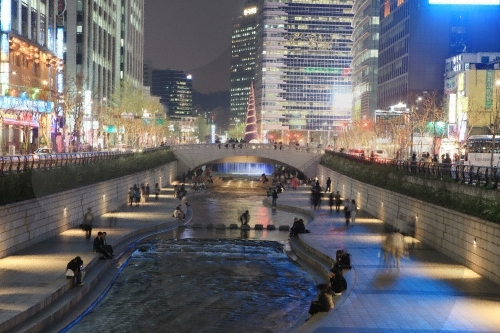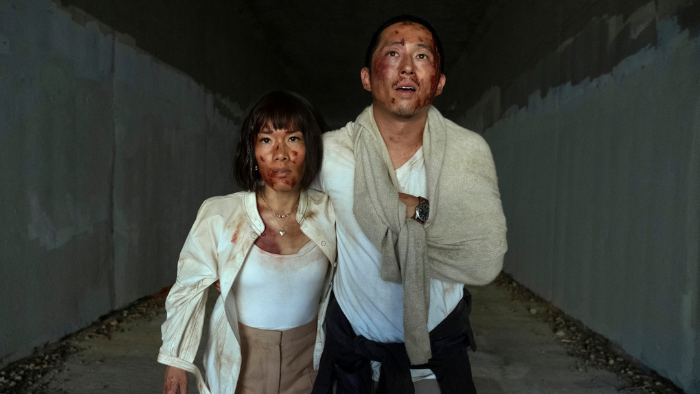Story and photographs by Bill Stephens
When you think Seoul, you envision a bustling capital city, with tall buildings, shopping centers, chainrestaurants and car-packed streets. The concrete jungle, in fact, has long had a reputation for being pedestrian-unfriendly. However, in the past 20 years, Seoul appears to be remaking itself, and in substantially greener shades.
A visit to Cheonggyecheon, smack in the middle of Seoul’s central business district, illustrates this point. Three years ago, the city spent about $330 million to liberate the stream (cheon in Korean), which was trapped under a concrete expressway overpass. A typical day now finds city dwellers and visitors strolling alongside the 3.5-mile waterway, lit up at night by rocks with colorful LED lights inside them. Children playfully jump across the stone steps in the water, and fountains, waterfalls, bridges and murals adorn the newly uncovered stream.
After this success story, the push for creating a more “livable,” pedestrian-friendly Seoul has gained momentum, and park supporters couldn’t be more pleased. “A prospering economy and maturing democracy changed people’s consciousness, and the desire for parks and other green areas increased,” explained Seoul National University landscape architecture professor Hwang Keewon.
Cho Sehwan, a landscape architecture professor at Hanyang University, added: “It’s part of the 21st century global urban regeneration trend. The creation of more parks matches citizens’ needs for improved quality of life.”
***
Following the 35-year colonial occupation by Japan and the Korean War, as Seoul began rebuilding its devastated country in the 1960s, some of the parks and green spaces that survived were actually destroyed in favor of unbridled development. However, beautification efforts in preparation for the 1988 Seoul Summer Olympics marked a turning point. And since the 1990s, democratically elected and locally autonomous mayors, such as South Korea’s current President Lee Myung Bak who formerly served as the mayor of Seoul, reportedly realized that the city’s emerging middle class increasingly longed for a more livable town.
Then-Mayor Lee is credited with leading greening efforts, like the building of Seoul Forest and the liberation of Cheonggye Stream. Other notable green schemes included World Cup Park, the Mt. Namsan Park restoration and City Hall’s grassy front lawn.
Choi Yoonjong of the city government’s Green Seoul Bureau says it’s an exciting and busy time, as the city prioritizes building new parks and improving old ones. “By law, we have a new mindset in Korea,” said Choi. “We no longer allow parks and green spaces to be taken for development.”
[ad#336]
Choi, who studied forestry in Korea and later, recreation, sports and tourism in the United States, said the city has a budget to purchase land for parks and that it works with the nonprofit Seoul Green Trust, to generate ideas for new ones. At times, the green space builders have to get innovative, considering the limited landscape in the highly developed city. For example, a former waste dump was converted into World Cup Park. A public golf course became Seoul Forest, and the city purchased an abandoned brewery to create Yeondeungpo Park. The city is even offering financial incentives to building owners who install rooftop gardens and now requires new developments to incorporate park space as part of their projects.
Of course, the city has met with a fair share of opposition to this greening movement. Critics of the Chonggyecheon Stream project, for example, protested the displacement of local merchants as well as the hefty cost, which paid for removing three miles of highway and building seven miles of pipe to pump water there artifically from the Han River. “But the city persuaded people with economic compensation and traffic alternatives, and by constructing a new building for displaced merchants,” said Hanyang University’s Cho.
And now many of those who protested the stream’s recovery are enjoying its fruits: reduced air pollution, increased foot traffic and higher property value in the surrounding area. An estimated 60,000 people daily visit the stream, where the number of fish species increased from four to 25.
Choi said the big challenge these days is the cost of buying land. “Owners want more and more from the city. Land prices are very expensive in downtown Seoul.”
Choi offered to show this reporter Seoul Forest, a $243 million, 280-acre park (one-third the size of New York’s Central Park) built for both nature viewing and recreation. Seoul Forest, co-managed by the city and Seoul Green Trust’s Seoul Forest Conservancy, boasts 48,000 trees, attracts 10 million visitors annually, and is staffed by 130 volunteers who help maintain the grounds and run environmental education programs.
Inside, we passed gardens, playgrounds and areas for picnics and cultural events. Then we drove on a pedestrian bridge, from which we viewed a sprawling ecological forest, the park’s main area and wildlife sanctuary. We paused to observe deer, whom visitors can feed during certain hours. “The deer are the most popular feature of the park,” Choi said, noting that there 120 deer here, as well as squirrels and ducks.
We drove over an eco-bridge to see where Seoul Forest meets the Han River. En route back to the main entrance, we stopped to chat with park visitor Hay Sunyoung, who was being wheel-chaired around by a caregiver.
“This place is special,” said Hay. “Beautiful. Clean air. Coming here opens my mind.”
A 20-minute taxi ride later, an interpreter and I entered World Cup Park, which Choi had told me “used to be a dirty smelly place, where garbage and trash were dumped.” As we walked I discovered 840 acres of lush greenery, with ponds, gardens, picnic spots, playgrounds, and walking and biking trails. The day’s visitors included a group of bicyclists picnicking under the shade of trees.
“Our bike group cycles here four times a week,” one of them said. “It’s like a forest, with clean air, a good environment and a good bike trail. It’s easier biking here than to the mountains.”
***
“Seoul’s made progress, but we have a ways to go,” said Seoul Green Trust Secretary General Lee Kangoh, noting that the World Health Organization recommends at least 9 square meters of park space per city resident. Seoul has improved in recent years from 4.5 to more than 5 square meters (excluding surrounding mountains). New York City has 14 square meters per resident.
Lee’s six-year-old nonprofit, with 16 employees and funded by donations, works as a partner with the city to expand green spaces. “We’re like a brain trust,” explained Lee, who has worked on forestry projects in the Philippines, Maldvies and India.
He said it’s difficult to make Seoul green in large part because of the city’s 20th- century urbanization. “Today, 82 percent of the city is covered with concrete and asphalt,” he said. And even with the support of current Mayor Oh Sehoon to build more parks, there’s competition with parking and housing demands. Golf courses, too.
The group successfully protested plans to build a course at World Cup Park. A nature area was built in its place. “The golfers were angry,” Lee said. “But Seoul needs parks more than golf courses.”
Although Seoul Green Trust works on many large projects, Lee is especially enthused about recent efforts to create small neighborhood “pocket” parks. Each year the Trust creates six to 10 new pocketparks, averaging 500 square meters, about the size of a basketball court, often on empty land previously used for trash and parking. There are now more than 200 small neighborhood parks in Seoul. Lee’s goal is 1,000 by 2020.
“When Seoul was developed fast, the city’s traditional community system was destroyed,” said Lee, who complains that Seoul’s poor neighborhoods are “99 percent” covered by building and parking. “So when neighbors work together to create small parks, there’s also a social benefit.”
One of Lee’s favorite success stories is Mia Dong Park located in a southeast Seoul working-class neighborhood. “We taught the local people to care for the park,” he said. “When we finished, neighbors were so happy, they made us drinks and soup.
“I feel at home when working with people in neighborhoods,” Lee said. “We must persuade them. You can plant a tree in one week. But [in order to build a park,] we have to plant a seed in the community’s mind.”
***
Seoul’s push for parks appears to be moving forward full speed ahead. Dongdaemun Sports Stadium is currently being transformed into a park, as is an old private amusement park called Dream Land.
A $150 million project will improve Mt. Namsan Park by expanding green space, planting pine trees, adding rest areas and improving walking paths. When the 630-acre Yongsan U.S. Army military base eventually relocates south of Seoul, the vacated land will become a large park. Says Professor Hwang of Seoul National University: “Sooner or later, Yongsan will become Seoul’s ‘Central Park.’”
There are plans for a large north-south eco-corridor connecting Seoul’s large and small parks by 2015.
“I hope Seoul becomes an ‘eco-city’—a city that operates in the natural ecosystem,” said Prof. Cho Sehwan from Hanyang University. “To do that, we need to both add parks and introduce mixed land use, so Seoul will be whole.
“Parks and green spaces are not for decoration of the city,” he added. “They are properly left for future generations to live healthy and enjoy culture.”





